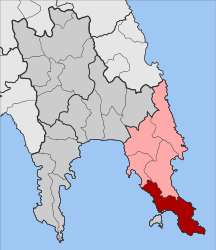|
Voies
Voies (Greek: Βοιές Greek pronunciation: [/viˈes/], feminine plural) is a former municipality in Laconia, Peloponnese, Greece. Since the 2011 local government reform it is part of the municipality Monemvasia, of which it is a municipal unit.[2] The municipal unit has an area of 215.527 km2.[3] It is on the southern tip of Cape Malea. It is a predominantly agricultural region with a few minor villages and one dominant town. Vatika is the common term for the area, but Voies is used in a more official context, particularly for postal situations. Voion, the genitive, is used for description: for example, to differentiate the village of Agios Nikolaos in Voies from other villages and towns of the same name, one would use Agios Nikolaos Voion. Neapoli is the administrative capital of the municipality, and is also the urban center to the numerous villages that surround the hinterland. In the Kato Kastania village of Voies is found the large and colorful Kastania Cave.[4] GeographyThere is a single mountain range that runs through the center of the municipality dividing it into two parts, both an east and west section. Adjacent to the west coast of the region lies the island of Elafonisos. The island contains some of the oldest evidence of human inhabitance in the whole of the Peloponnese. Historical population
HistoryThe name of the region derives from the initial name of the town of Neapoli, Boiai (Ancient Greek: Βοιαί), which is thought to have been founded in the second century BC. The feminine plural ending has evolved from -αί to -ες. The ancient writer Pausanias wrote that Boiai was founded "...by Boios, one of the Heraclidae, who is supposed to have gathered the people from three cities: Etis, Aphrodisias and Side". NeapoliNeapoli (Greek: Νεάπολη meaning "new city") (36°30′42″N 23°03′31″E / 36.51167°N 23.05861°E) is the largest town of the former municipality. It was initially an agricultural center, but now has seen a rise in the numbers of tourists (particularly visitors to the neighbouring island of Elafonisos). The commercial center of the town is located on the water front, facing Vatika Bay. There are ferries to the islands Kythira and Elafonisos. The town is surrounded by the villages of Faraklo, Paradisi and Lachi in its hinterland, and Kambos located on the same plain as Neapoli. Neapoli has a kindergarten school, a school, a church and a square. Agios NikolaosAgios Nikolaos (Greek: Άγιος Νικολάος) (36°28′38″N 23°05′53″E / 36.47722°N 23.09806°E) is a small village, south-east of Neapoli. It has a largely agricultural population; however, many inhabitants are employed in the shipping industries. Places of interestVillages:
See alsoReferences
External links |
||||||||||||||||||||||||||||||||||||||||||||||||||||||||||||


